
The University of South Carolina Gamecocks’ 20-acre Huskey/Dietrich Golf Practice Facility was created solely for the university’s golf team. Photo courtesy of the University of South Carolina
Tim Flanagan learned much of his trade at The Forest Lake Club in Columbia, S.C., where, as an assistant superintendent, he took to heart the regimentation of cultural practices and their relation to traditional play patterns, just like anyone else would in the low country.
Aerification took place three times a year — spring, summer and fall. When he topdressed, he did so on Mondays, to be sure the course was as pure as possible by the weekend.
But when Flanagan left for a new gig just down the road, these and several other basics of timing went straight out the window.
“Summer is the big time at most golf courses, but here, summer is the slow time,” says Flanagan, the golf facility superintendent at the University of South Carolina. “As a result, we jam our cultural practices into the summer months — to the extent we can — to avoid disrupting play. With aerification, I cram two big ones and one small one into the same two-month period. Same thing with verticutting. We’re way more aggressive in the summer months than any other time.”
Flanagan’s new gig is nontraditional and just happens to intersect with one of golf’s few remaining development booms: the university-themed golf practice facility. Flanagan has been with the University of South Carolina since 2016, when the school broke ground on the Huskey/Dietrich Golf Practice Facility, a 20-acre complex in the shadow of Williams-Brice Stadium that was created exclusively for the men’s and women’s golf teams.
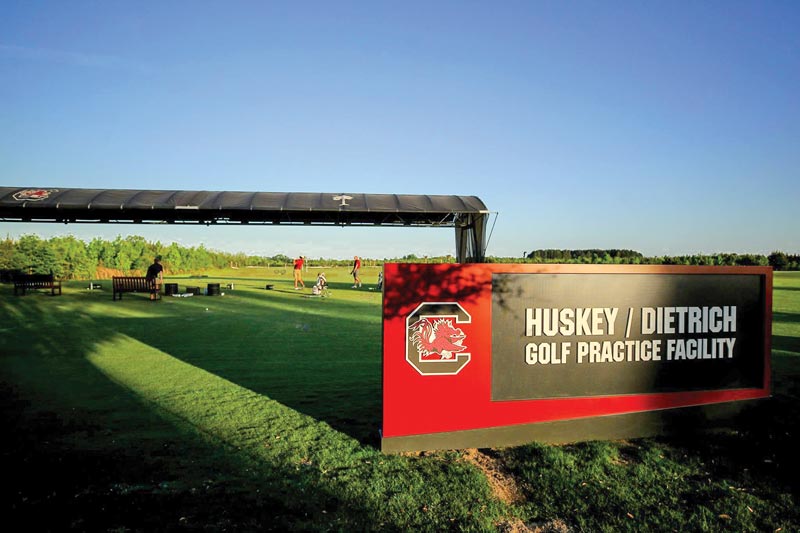
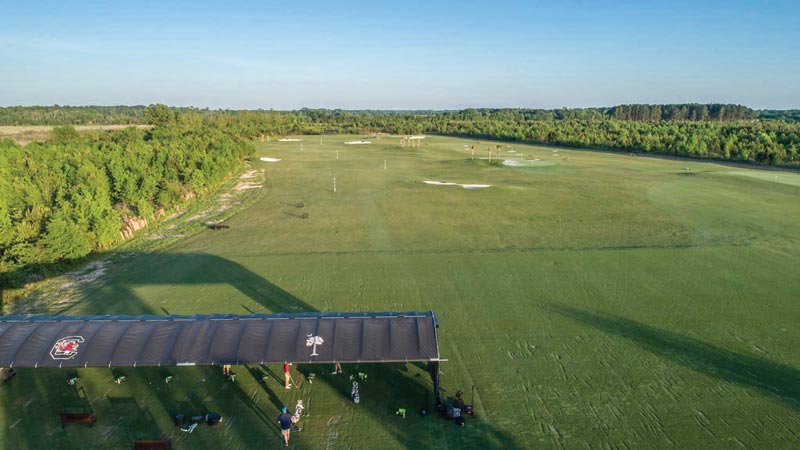
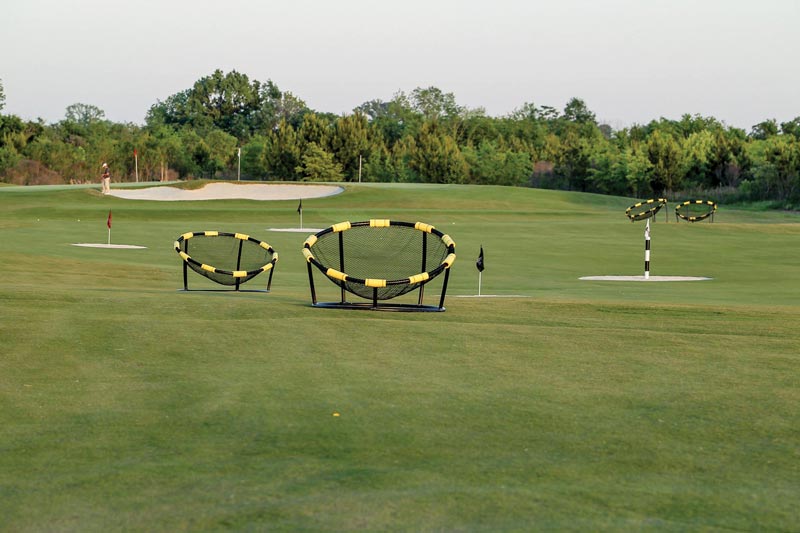
Among the amenities at the University of South Carolina’s dedicated practice facility: 400 yards of hitting space and three greens (middle), a short game area (bottom), and tees at either end. Photos courtesy of the University of South Carolina
No expense or expertise was spared. Landscapes Unlimited built the place according to a design from architect and Gamecock alum Beau Welling. The rectangular parcel features tees at either end, a pair of legitimate par 4s that play side by side, practice greens and a short game area, with 419 bermudagrass in the fairways and roughs and TifEagle bermudagrass on the putting surfaces.
During the past five years or so, dozens of similar facilities — some similarly stand-alone, others affixed to existing clubs — have been developed in college towns across the country. In some cases, you wouldn’t know these facilities were university-related. With others, the collegiate affiliation informs the entire complex. Either way, the job of maintaining these facilities brings with it unconventional cultural demands, scheduling and labor allocations.
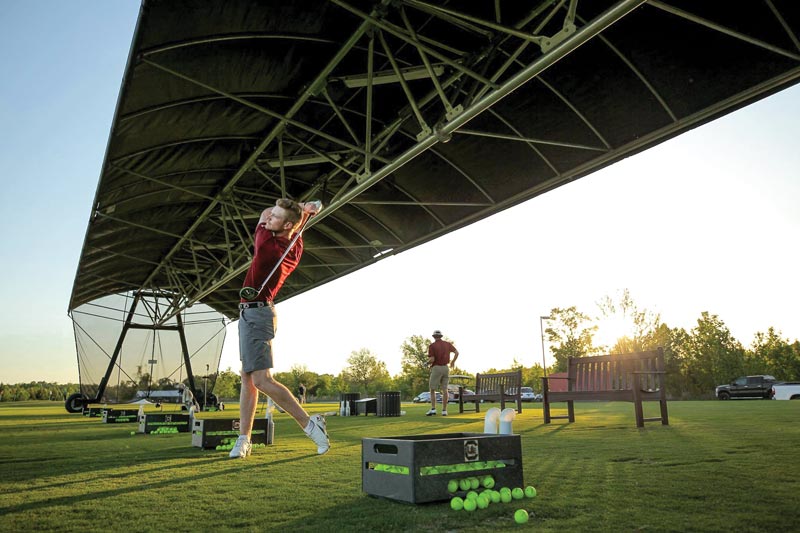
University of South Carolina student-athletes can tee off under a mobile canopy. Photo courtesy of the University of South Carolina
“For example, most golf courses topdress Monday or Tuesday, so greens are clean for heavy play on the weekend,” says Flanagan, a 10-year GCSAA member who leads a crew of one 40-hour-a-week and two 20-hour-a-week employees. “Not here. The golf teams practice Monday through Thursday. I topdress on Fridays — so it’s pure the following Monday. We have no weekend emphasis at all.
“At every other golf course, at least the ones I worked at, there were cart guys and range set-up guys. We do all that ourselves — pick the balls, clean them, set up the driving range. We’re a one-stop shop. It’s been an adjustment for me, trying to fit that schedule and manage this property and achieve as little disruption as possible.”
Lone Star leaders
The epicenter of this development — and maintenance — trend may well be Texas, where Lincoln, Neb.-based Landscapes Unlimited has, in the past three years, built college-specific practice facilities at Trinity Forest Golf Club in south Dallas (for Southern Methodist University), the University of Texas Golf Club in Austin (for the Longhorn golf teams), and The Traditions Club in Bryan, where Texas A&M commissioned Jeff Blume, current American Society of Golf Course Architects president, to design the Paul Wahlberg Aggie Golf Learning Center on 11 acres behind an existing range. Blume has overseen completion of another facility, this one for the University of Houston, at the Golf Club of Houston.
These development projects tend to attract alumni working in the business. Blume is a proud Aggie. In Austin, Longhorn alum Jordan Spieth collaborated with architect and fellow UT grad Roy Bechtol in creating the complex dubbed Spieth’s Lower 40.
“Basically, the school now has one end of the driving range, where there’s a new student clubhouse, hitting bays and offices for the golf team coaches,” says Brian Vitek, the project manager for Landscapes Unlimited on all three Texas jobs. “On the property there, between the range and the main course, Roy designed a six-hole par-3 course that can also be played crossways to get longer iron shots. Basically, he built into the facility all the shots you’d find on a full-length course.”
“You gotta keep up with the Joneses,” says Bechtol, who has talked to LSU and Ole Miss about designing the same sort of facility for those schools. “All these schools are vying for talent out of high school. Some kid walks out there and sees all that, and they say, ‘Oh my God. Where do I sign?’ It’s a great recruitment tool. But I see resorts and mixed-use resorts doing this sort of thing too. The greens average 2,600 square feet, so about half size. But it’s not goofy golf. It’s beautiful out there and fun to play. All zoysia in the fairways — most kids play it with their shoes off.”



In Austin, Texas, University of Texas graduates Roy Bechtol and Jordan Spieth collaborated on a six-hole par-3 course dubbed Spieth’s Lower 40. The Longhorns’ practice facility features zoysia fairways, allowing it to serve as a mini test site for the main course, the University of Texas Golf Club. Photos courtesy of Bechtol Golf Design
The use of zoysia on the Lower 40 illustrates the utility these facilities can have, not to the golf team necessarily, but to the club itself.
“These practice facilities are the real deal — USGA greens, Capillary Concrete bunkers, capped-off irrigation systems,” Vitek says. “All that is standard. The folks at UT asked us to use one of the newer zoysias on the Lower 40, creating a mini test site. The club has a 5- to 8-year upgrade plan, and this lets the membership see how Zeon or L1F will look and play if someday they choose it for the main course.”
Yet that sort of club-centric accommodation is relatively rare in this development scenario. In many cases, it’s all about the college golf program and its needs.
At Trinity Forest, the bunkers at Southern Methodist University’s practice facility feature three types of sand to best mimic the sort of conditions teams will encounter at tournaments in places such as Florida and Southern California. “There are three bermuda greens up there,” says Kasey Kauff, the GCSAA Class A director of agronomy at Trinity Forest, “but we overseed two of them so they can practice playing on cool-season grass.
“You see what these schools spend on football and what the coaches make, but I didn’t realize the arms race that was going on in golf. Up at our facility, they have a legit clubhouse, a 5,000-square-foot building with a common area, pool table, air hockey, TVs, couches, men’s and women’s locker rooms, weight room, kitchen and offices for both coaching staffs. It’s crazy — all for college golf! Of course, every kid who gets recruited, they send ’em right up there.
“When I was at N.C. State, they built the golf team a practice facility,” the 15-year GCSAA member continues. “That was 15 years ago. If I saw that facility today, I’d probably say, ‘Uh, that’s not going to cut it.’”
Keeping up with the Joneses
As it happens, North Carolina State is now in the midst of planning major upgrades to all the practice facilities at university-owned Lonnie Poole Golf Course, according to Brian Green, the facility’s GCSAA Class A director of golf course maintenance. Lonnie Poole already serves more masters than most: The school offers respected turf management and professional golf management programs, both of which operate from the 18-hole facility.
What’s more, the Wolfpack were pioneers in creating a short game area specifically for their varsity golf teams. That facility opened back in 2004 — on campus, not at Lonnie Poole. But a pending highway project will soon impact the short game parcel, and the school is in talks with Palmer Course Design Co. to bring the existing range up to snuff and consolidate all the golf-related facilities at Lonnie Poole.
“We have a driving range today that really is not adequate, even for the general public,” says Green, a 20-year member of GCSAA. “We’ve had conversations about building a nice facility that would benefit the golf team and the junior golf program here — and the PGM program — but nothing’s in place yet. There is ongoing dialogue, but things are still up in the air.
“Just listening to our golf coach talk, they’re trying to maximize their practice time. They’re trying to take into account different lies, precise distances. It’s limiting to have a driving range where you can only hit one direction in a prevailing wind. They’re thinking a lot about things the common golfer doesn’t, but yeah, there’s a tremendous amount of money going into college golf these days. It really is an arms race.”
There’s nothing revolutionary about college-owned/affiliated golf courses. They’ve been around forever. However, in a development climate that is more or less devoid of new construction, at least in the U.S., colleges and universities come at the renovation exercise with specific desires — and lots of capital, especially compared to your typical private club or daily fee. At Indiana University Golf Course in Bloomington, the 18 holes have been closed all year for a top-to-bottom renovation by architect Steve Smyers. When it reopens later this summer, it will include a new practice facility designed specifically for the men’s and women’s golf programs.
Rock chalk upgrade
At newly rebranded The Jayhawk Club in Lawrence, Kan., GCSAA Class A director of agronomy Greg Burdiek presides over another complete, university-inspired makeover. The former Alvamar Country Club had featured 36 holes of golf — 18 holes public, 18 private. The Jayhawk Club will be a 27-hole facility. Acreage once devoted to the fourth nine is being converted to a massive practice facility dedicated to the University of Kansas golf teams.
“It’s exciting to be a part of it all, and the thinking is, this will help anchor the club,” says Burdiek, an 11-year GCSAA member who arrived in spring 2018 from the 36-hole Country Club of St. Albans outside St. Louis. “Alvamar had been waning in terms of how they were doing financially. To have KU affiliated so strongly with this place, it bodes well for the club. It makes what we’re doing unique, not just another renovation.”
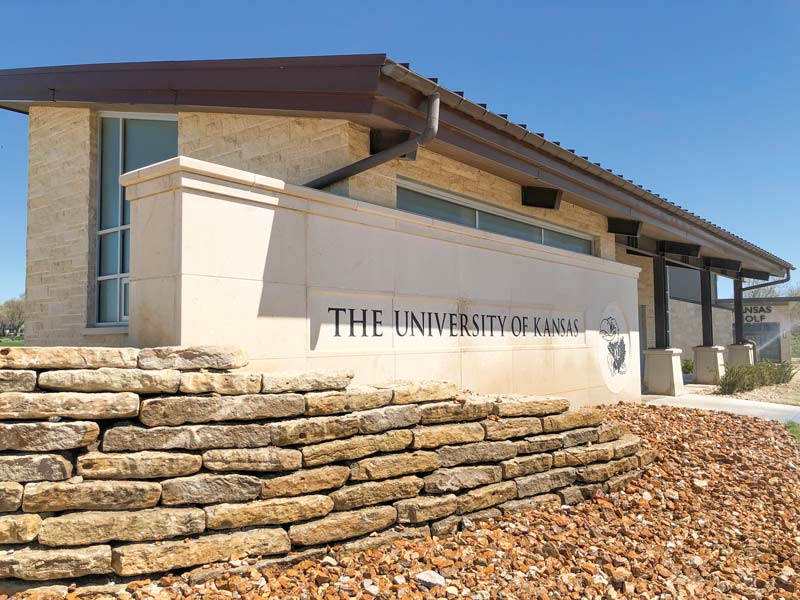
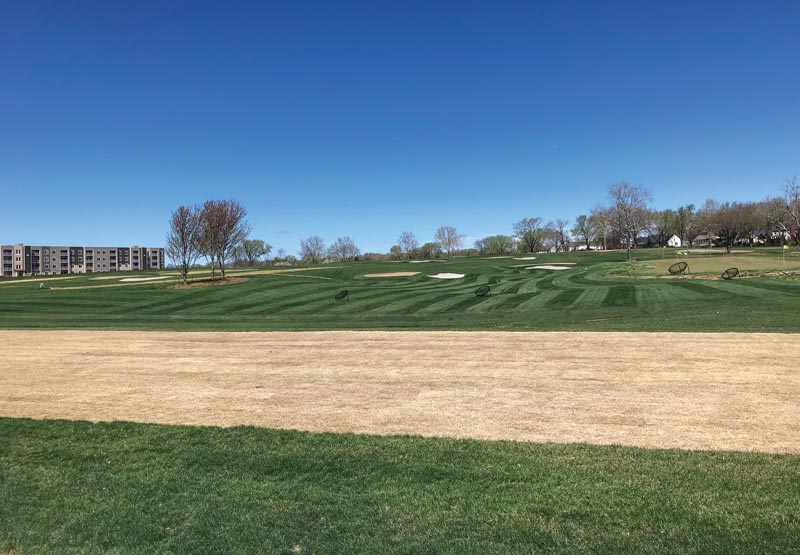
In Lawrence, Kan., University of Kansas golfers soon will practice at newly rebranded The Jayhawk Club. The former Alvamar Golf Club had featured 36 holes — 18 public, 18 private. The makeover will have 27 holes, plus a 30-acre practice facility for the university. Photos by Roger Billings (top) and Greg Burdiek
Everything is being or has already been redone at The Jayhawk Club — 27 holes redesigned by architect Mike Gogel and a new clubhouse and fitness and pool facilities. A portion of the land that had been devoted to golf is now home to an apartment complex. Some 30 acres have been set aside for the new university practice facility.
“I was actually aware of this college practice facility phenomenon before I got here,” Burdiek says. “But I was frankly unaware of just how high-end they were. I’d seen photos of a facility they have down at the University of Georgia, and I said to myself, ‘Holy cow! That’s top-end.’ It was the real deal, and that’s what we’re doing here.
“The goal is to have it finished later this year. The greens have been shaped, the irrigation is in. We’ll have three tees, two zoysia and one bent. We may convert one to bermuda to get them some practice on that surface, because they play a lot of tournaments in the South.”
A Mustang mindset
Two-year-old Trinity Forest Golf Club burst into the broader golf consciousness last spring when it played host to the PGA Tour’s AT&T Byron Nelson Classic, something it will do each May going forward. It was developed by several SMU alumni.
“So this was always going to be the home course for SMU,” Kauff says. “In fact, I believe that when Payne Stewart died, he was flying to Dallas to talk about doing a course for SMU. So it’s been there for a long time, this idea, and SMU was always part of it.”
And there’s certainly nothing novel about college teams using independently owned private clubs as their home course. It’s a balancing act Kauff and other superintendents continue to manage.

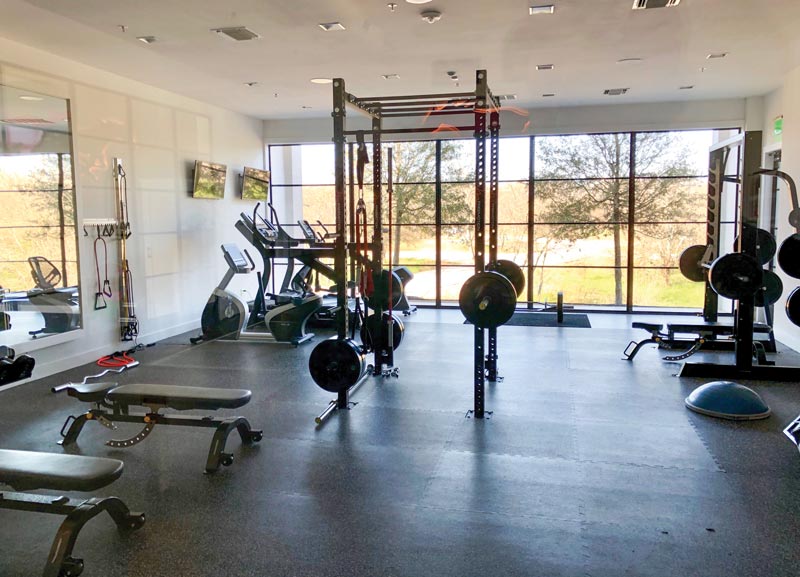
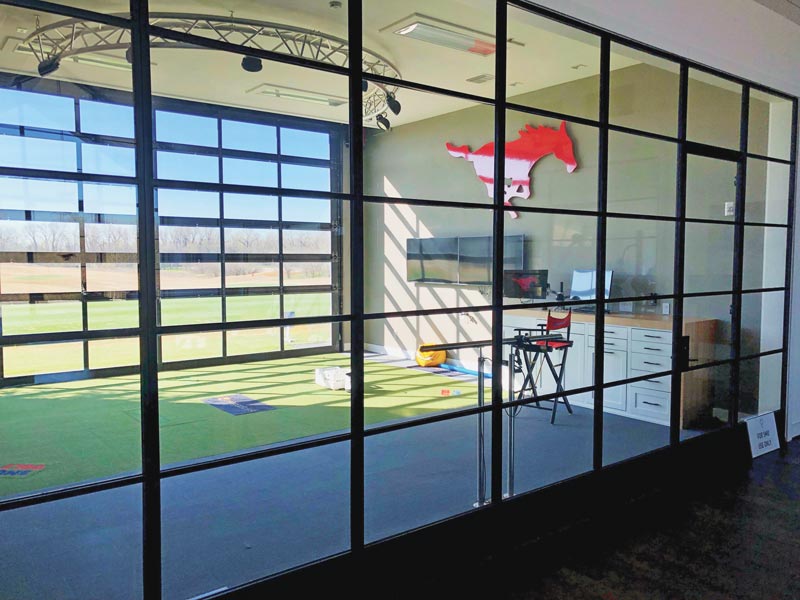
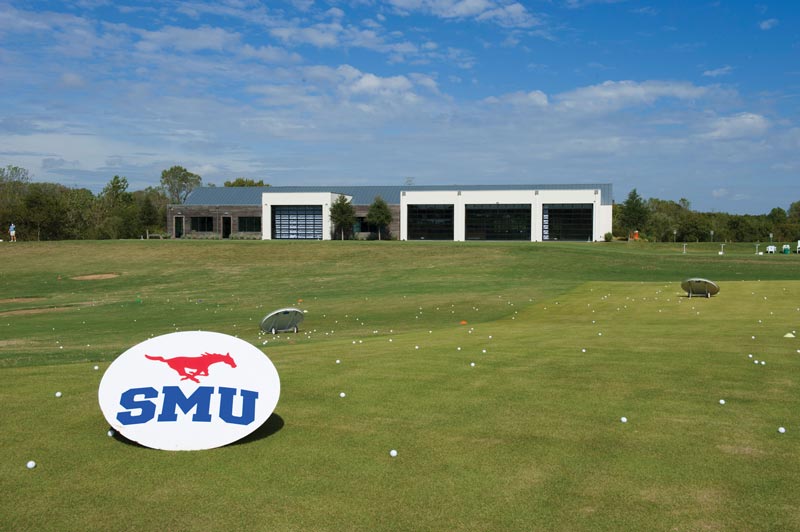
At Trinity Forest Golf Club in south Dallas, Southern Methodist University’s practice facility features the Payne Stewart SMU Golf Training Center (top) with a weight room and high-tech hitting bay (center), among other amenities. Outside, there’s 70,000 square feet of teeing ground, a 45,000-square-foot putting and chipping green, and a nine-hole short course (bottom). Photos courtesy of Southern Methodist University/Kasey Kauff
Trinity Forest sits on two separate parcels — two former landfills, actually. The main clubhouse and course rest comfortably on about 200 acres just south of Highway 12. On the north side of the highway sits the practice facility, which includes a 15-acre range, 3-acre short game area and 20-acre par-3 course. Kauff says members use the range but not much else. The range features three tees facing south, west and north. SMU essentially has sole run of the north, where its dedicated clubhouse sits.
“We built a real nice short game facility up there that members can use but don’t use much,” Kauff says. “These kids practice a lot. That short game area is pretty much theirs.”
This complex is a world apart in every sense. Kauff even deploys a separate superintendent — seven-year GCSAA member Adam Deiwert — crew and equipment fleet to maintain it all.
“Because it’s on the other side of the property, the furthest point from our shop, Adam has his own staff and equipment,” Kauff says. “I treat it as a separate entity, to be honest. I budget it separate from the main golf course. If we have an outing on a Monday, we’ll send staff up there to work on the place, but otherwise Adam has eight guys on staff dedicated only to the practice facility.
“It makes sense. He’s bermuda up there; we’re zoysia. They use a heavier reel up there, so they need different mowers anyway. We don’t have rough here on the main course; they do across the road, so it really is a different, totally separate deal over there.”
Trinity Forest shuts down the entire golf course and practice facility for a month every August. But as with the cultural practices at South Carolina’s stand-alone facility, the college golf schedule sets the agenda.
“We don’t reopen for membership until Sept. 1, but the kids come back in mid-August, and they do play the golf course,” Kauff says. “We aerify all the greens on the par-3 course and the short game area in July, so it’s ready when they do come back. That’s before the golf course gets done, because it’s still closed.
“The SMU ladies do qualifying every week, to determine who’s going to compete in the matches. They’ll play 18 regulation holes, then a nine-hole par-3 match. The other day, we didn’t overseed or do anything cultural until those matches were done. We wait for them.”
Hal Phillips is the managing director of golf and resorts for Mandarin Media, a public relations firm with offices in Portland, Maine; Park City, Utah; and Ho Chi Minh City, Vietnam. He is the former editor of Golf Course News.